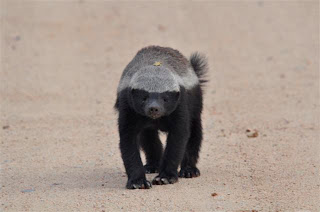Layout
Here I have looked at double page spreads in order to consider design influences in relation to layout for my double page spread.
---------------------------------------
Scientific Drawing
One area I of aesthetic I considered using as a theme was the use of scientific drawings. I love Da Vinci - esque drawings, and so I considered these as an influence, and possible something I could use.
Here I have explored drawings and diagrams of European Badgers:
Badger Research
Obviously for the 500 word content about badgers, I needed to look into the animals themselves:
There are 7 main types of badger, so I've decided to research briefly into each of them, then chose 5 to put on my double page spread.
1. European Badger - Meles Meles
The Eurasian
badger is about 3 feet (90 cm) long, with a 4 inch (10 cm) tail, and weighs
about 30 pounds (13.6 kg). The distinctive trademark of the badger is the white
head with black stripes along each side of their face. Their ears are rounded
and they have small white-tipped ears. From a distance they appear to be
grey in colour, but actually they have coarse black and white hairs over a
brownish yellow "underfur". There is a small group of reddish
badgers endemic to Britain. The face of the Eurasian badger is longer and
narrower than it's American cousin. They have been known to fill in another
burrowing preys exit hole, before attempting to reach them through another
entrance.
----------------------------
2. American Badger - Taxidea taxus
Adult badgers measure 30 inches (76cm) to 35 inches
(89cm) in length, including a short furry tail averaging 5.5 inches (14
cm). Their bodies are wide and give a flat backed appearance. Many
adult badgers weigh 12 pounds (5.4 kg) to 16 pounds (7.3 kg), although weights
might increase to over 20 pounds (9.1 kg) in the late fall as they store up
layers of fat to sustain them during periods of cold weather and deep snow.
Colors are mostly gray, with a grizzled effect due to
long guard hairs that have a black band ending in a white tip. Their
"underfur" is either a light tan, or a creamy white. A white
stripe from the nose leads between the eyes and back over the head of the
badger, ending between the shoulders.
----------------------------
3. The Honey Badger - Mellivora
capensis
The Honey Badger
is about 2 ft (61 cm) long excluding the tail, it has a coat that is black on
the lower half of the body and pale gray above. The honey badger resembles its
distant relative the skunk in coloration and in the possession of an anal scent
gland. The honey badger has short legs and stout claws and is a strong
burrower and a good climber.
Interestingly,
the honey badger collaborates with the indicator bird, in obtaining honey, a
favourite food. The bird searches for a bee colony, and when one is found, the
honey badger rips it open. The bird and the honey badger then share the honey.
They are omnivorous and will also eat insects, rodents, birds, eggs, snakes,
roots, fruits and tubers.
----------------------------
4. Ferret Badger - Melogale personata
The smallest of
the badger family, only reaching a weight of 2.5 lbs (1.1 kg) to 7
lbs. (3.1 kg). Their bodies reach a length of 13 inches (33 cm) to 17
inches (43 cm). They are also called tree badgers, or pahmi. Aside
from the Burmese and Chinese ferret badger there is Everett's ferret badger Melogale everetti,
which is only found on Mount Kinabalu at the northern tip of the island of
Borneo.
The honey
badger's anal glands secrete a vile-smelling liquid to deter its enemies,
whereas ferret badgers, the teledu and the Palawan stink badger will squirt the
contents of their anal glands into the face of an attacker.
5. Palawan Stink Badger - Sullotaxus marchei
The Palawan stink
badger's body reaches a length ranging from 12.6 inches (32 cm) to 18.1 inches
(46 cm). Their tails range from .4
inches (1 cm) to 1.6 inches (4 cm).
It gets its name
from the fact that its scent is very strong andoffensive. The honey badger's anal glands secrete a
vile-smelling liquid to deter its enemies; whereas ferret badgers, the Teledu
and the Palawan stink badger will squirt the contents of their anal glands into
the face of an attacker. The Palawan
stink badger can reportedly strike a target up to 39 inches (1 m) away.
Other Options:
I also came across this image of all the previous badgers in one image:










































